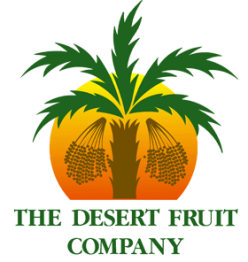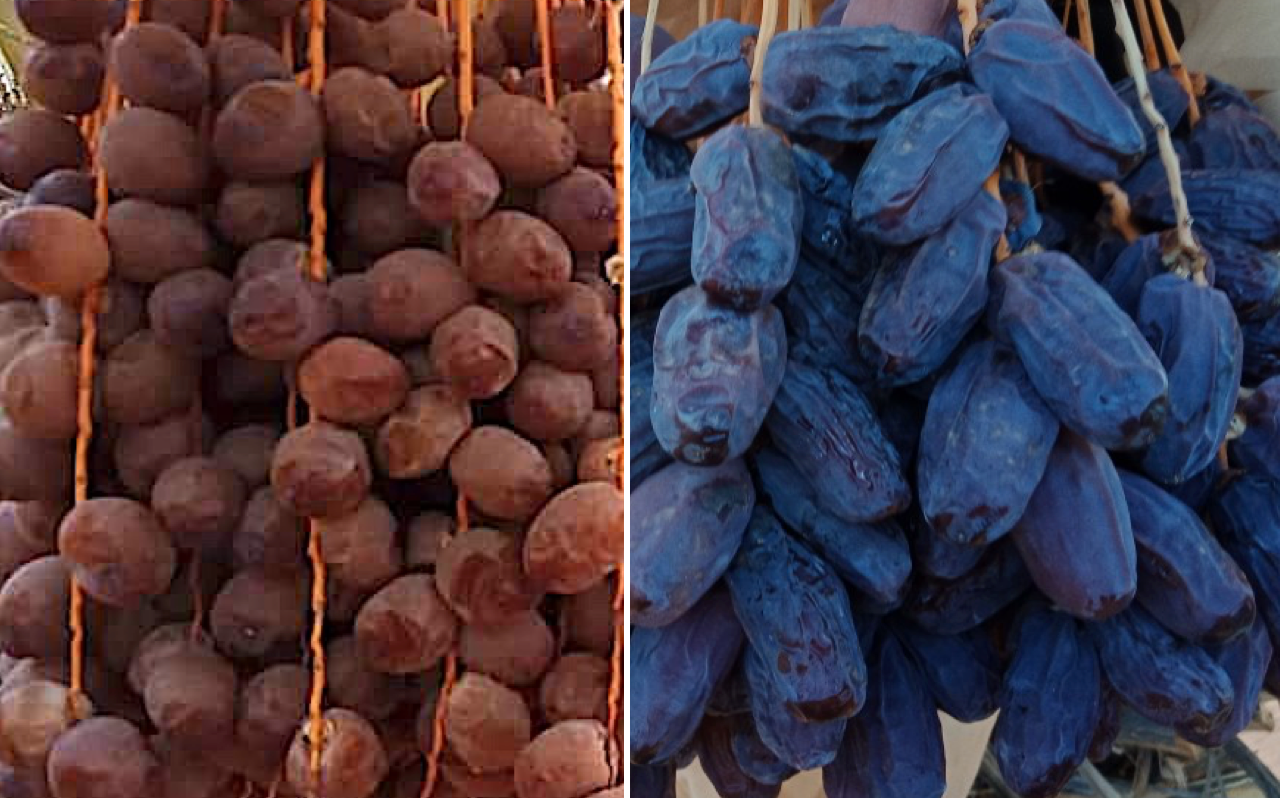About growing, harvesting and selling our dates

It's a team effort!
Growing dates is a labour intensive process!
A huge thankyou to everyone out there who has contributed to the date farm over many years.
Below is a gallery which shows some of the steps in the process of growing, harvesting and selling our dates.
Each stage is different and we will add more detail to each step in coming years.
Stage 1 - Flowering
Dates are dioacious which means there is a male and female palm. Our season starts in about September when the male and female flowers start to emerge. We collect the pollen from the male flowers and use it to hand pollinate the female flowers.

Caption
Male flower ready for picking
A male flower full of pollen and ready for us to pick.

Caption
Male flowers pre-pollen collection
Male flowers hanging up out of the wind. Individual flowers in the bunch gradually open up and release the pollen inside.
We extract the pollen by beating the flower on a bench and sweeping up the pollen into a jar.

Caption
New female flower
A new female flower pushes open the spathe. This is about the stage where we would pollinate the flower.
Stage 2 - Pollination
After collecting enough pollen from the various date varieties on our farm we use a home made blowing-pipe that spreads the pollen to the flower.
Typically this happens shortly after the pollen collection and we just have to go hunting for the female flowers that are ready.

Caption
Pollinating process
Pollinating from one of our cherry pickers.

Caption
Pollinating process (cont'd)
Some opportunistic pollinating from the roof of the car... The pollen is in a jar - you blow through a flexible plastic hose into the jar and this puffs the pollen up into the flower.

Caption
Pollinated flower
An older female flower - the white patches are where we have puffed our pollen mix into the flower.
Stage 3 - Growing & care
Growing bunches are thinned to ensure quality fruit. The thinning process also give us a chance to visit each tree and de-thorn the fronds. Date thorns are up to 100mm long and will easily puncture a tyre so cutting them off is a big part of making it safe to work in the palms! We also tie each bunch of fruit down to a nearby frond to prevent the stem from breaking under the weight of the fruit and and bag it to stop the ring neck parrots and galahs from destroying them.
The palms are pruned once the fruit is bagged as more energy goes into fruit production and the lower fronds die off.

Caption
"Hababouk" dates
A female flower pre thinning, just starting to get all tangled up in the fronds. Dates at this stage are called "hababouk".

Caption
Thinned and bunched
This flower has now been thinned and tied up to stop it getting tangled in the palm canopy.

Caption
Unpollinated flowers
This is what happens when the female flowers are not pollinated. Two of the three points in this flower would have withered away if it had been pollinated, allowing one to grow into a mature date.

Caption
Protecting the growing dates
A bunch of Zahidi dates at the 'hababouk' stage in a protective bag.

Caption
Protecting the growing dates (cont'd)
These Deglet Noor dates have been bagged to prevent them from being damaged by birds or rain.
Stage 4 - Harvest Season
Our harvest usually starts in mid February and can continue through until early May. Some varieties such as medjool and barhee require dates to be individually picked whereas others (like the Zahidi and Thoory) can be picked a strand at a time. Very soft varieties need to be dried before we can pack them into boxes. This year we will be using a solar drying system to achieve better consistency in the drying process. All of our fruit is hand graded to ensure high quality is maintained.

Caption
Ready for harvest?
Dirfferent varieties ripen and are ready to be picked at different times.
The team monitor daily to ensure fruit is picked at the optimal time.

Caption
Harvesting
When a palm is ready to be harvested, we load the dates into farm trailer and take back to the processing shed.

Caption
Drying
Depending on the variety sometimes it is necessary to allow the dates some extra time to dry or ripen off the palm.


Caption
Packing
All dates are packed and weighed and then stored in our on-site cool-room.

Caption
Ready for sales & distribution!
Pictured here are Barhee Khalal dates, all packed and ready for shipment!
Stage 5 - Sales & off-season
Once the harvest is finished and the dates are sold there is quite a lot of cleaning up to do in the plantation. All the old flower stems are cut out and we prune again to keep good air flow in the canopy.
Fertilising and spraying for parlatoria scale are undertaken opportunistically throughout the year.

Caption
Sharing our dates with the local community ... and the world!
Catch us at the local markets in Alice Springs' Todd Mall or order online to try our dates.
These days some of our varieties are even available for export.

Caption
Eating dates!
Consuming delicious fresh dates is one of the best parts of the post-harvest season. We also love dreaming up new date recipes or ways to enjoy date products.
If you have a great date-recipe, we'd love to hear from you!

Caption
Pruning
Keeping our date palms healthy and well-maintained ensures that date production is maximised - and that dates are easily accessible at picking time!

Caption
Clearing and mulching
Date palms create a lot of mulch and organic material each year. We break this down and use around the farm.

Caption
Next generation
Whilst our farm is not intending to expand the grove significantly, we regularly make new plantings, especially of new and interesting varieties.
Frequently Asked Questions
FAQs
Is the Desert Fruit Company a cooperative?
Is the Desert Fruit Company a cooperative?
Are your dates organic?
Please see here
Are the dates processed in any way?
Some varieties of dates are very soft when we pick them off the palms. If they are too soft to handle we dry them on stainless steel trays before we pack them into boxes so they don’t get squashed or go soggy in transport. However, there is nothing whatsoever added to the dates – they are left as nature intended.
Khalal? Rutab? Tamar? What are fresh dates anyway?
Some varieties of dates can be eaten ‘fresh’ or khalal. When they are at this stage of ripeness, they are yellow and crunchy and need to be stored refrigerated. It’s a delicious way of eating dates that many people in Australia aren’t familiar with. As they ripen, the dates soften and turn brown and translucent, progressing to the rutab and then the tamar stages of ripeness. Confusingly, these are sometimes also called ‘fresh’ dates. We try to distinguish between these different stages of ripeness by using the Arabic terms or saying ‘fresh’ for khalal and ‘semi-dried’ for when the dates turn brown.
How should I store dates?
All of our dates are best stored refrigerated.
Refrigeration is essential for khalal dates and for the softer varieties, especially medjool.
Khalal dates will last about a week and rutab or tamar dates will last up to six months in the fridge.
Dates can also be frozen and thawed as necessary.
Where can I buy your dates?
We are able to sell our dates all over Australia as our farm has fruit fly free status and the majority of our sales are direct to customers.
As we are a small farm and can’t currently meet demand for Australian grown dates within Australia we aren’t exporting anywhere else at the moment.
Why can’t I buy your dates all year round?
We are a small farm and our harvests vary from year to year. Further, Australia imports many thousands of tonnes of dates a year so there is no way we could ever meet current demand for dates from our property!
We generally harvest in February and our dates are available until they are sold out (generally mid year).
Can I come and visit the farm?
Even though there are times when we are run off our feet, there is usually time for a cup of tea.
However, we need our visitors to be self reliant, have their own 4WD and understand that Tamara Plantion is a working farm in the bush with an abundance of prickles, flies and biting things!
So if you would like to come and visit our beautiful farm please contact us for details on how to get there.
Can I come and volunteer at the farm?
Please see the section on Volunteering/WWOOFing here.

